

न्यूजट्रैक के नए ऐप से खुद को रक्खें लेटेस्ट खबरों से अपडेटेड । हमारा ऐप एंड्राइड प्लेस्टोर से डाउनलोड करने के लिए क्लिक करें - Newstrack App
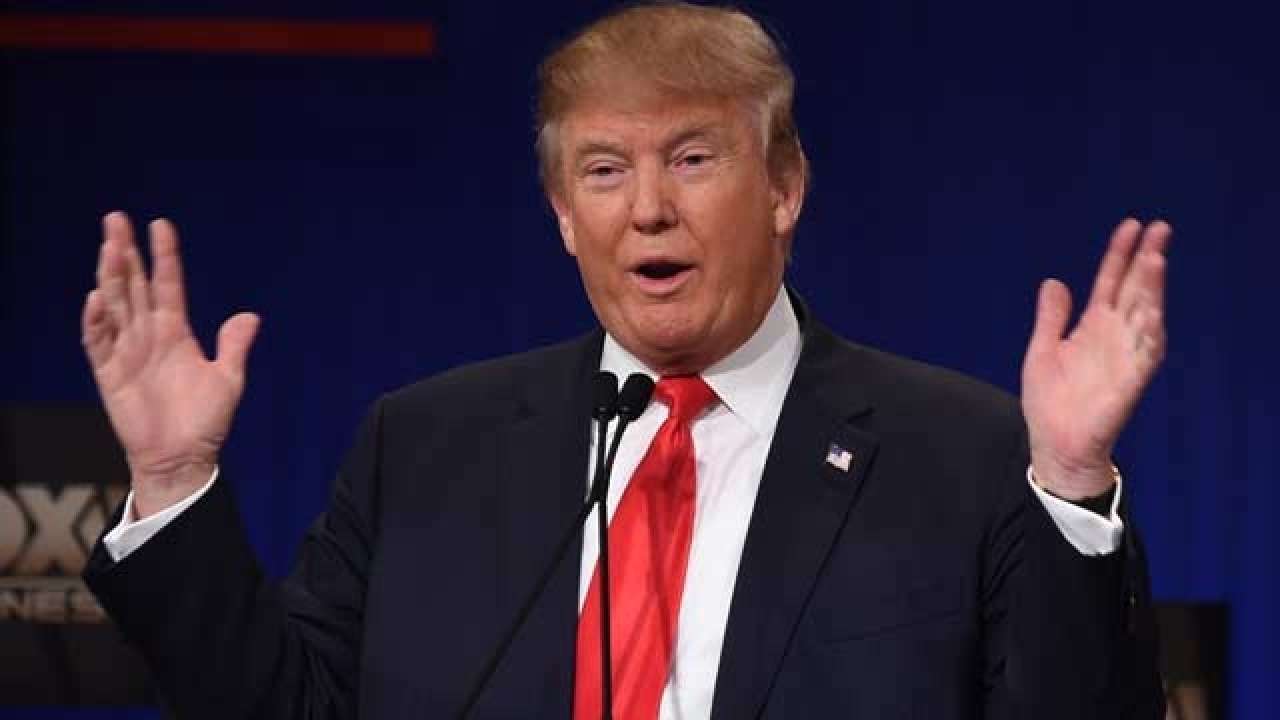
In yet another amusing statement, United States President Donald Trump said on Wednesday that the coronavirus pandemic will go away after a chunk of the population developed 'herd mentality'.
Trump made these statements when he was being interviewed by George Stephanopolous in a talk show.
"...you'll develop, you'll develop herd like a herd mentality. It's going to be, it's going to be herd developed and that's going to happen. That will all happen," Trump stuttered while making this not so coherent statement.
Trump doesn't even acknowledge that he made a mistake in his following statements.
"It will go away without a vaccine?" Stephanopolous asked again, to which Trump replied, "COVID-19 will go away quickly if a vaccine was made available."
Obviously, what Trump meant to say was that the COVID-19 pandemic will go away when the population develops 'herd immunity' not 'herd mentality.'
Herd immunity is a resistance developed naturally against the contagious disease when the majority of the population has been infected with COVID-19 and has successfully recovered from it. When a population develops herd immunity, it is meant to be safe from the disease.
Till now the United States has not reached herd immunity, and scientists say that there is still a long way before the United States can develop herd immunity. Therefore the population is advised to follow the required COVID-19 protocols before a vaccine is rolled out for the world, successfully completing various stages of the trial phase.
Coronavirus has affected more than 29.6 million people with 9,36,000 deaths worldwide. The United States is the worst affected COVID-19 nation with 6.61 million people with 1,96,000 deaths.



न्यूजट्रैक के नए ऐप से खुद को रक्खें लेटेस्ट खबरों से अपडेटेड । हमारा ऐप एंड्राइड प्लेस्टोर से डाउनलोड करने के लिए क्लिक करें - Newstrack App
Barcelona head coach, Ronald Koeman, has named a strong squad to face Girona in today’s pre-season friendly fixture at the Johan Cruyff Stadium.
Koeman released a list of 23 players to tackle the Segunda División side in a post via the club’s official website on Wednesday.
Barcelona head to the game after defeating Gimnastic 3-1 in their last fixture last Saturday.
Barcelona squad against Girona: Neto, Iñaki Peña, Arnau Tenas, N. Semedo, Piqué, Sergio, Griezmann, Messi, O. Dembélé, Coutinho, Lenglet, Jordi Alba, Braithwaite, S. Roberto, F. De Jong, Junior, Aleñá, Trincao, Pedri, Riqui Puig, R. Araujo, J. Cuenca and Konrad.
The kick-off time for the friendly match is at 6 pm.
67
71
71
73
The good looks of the Realme 1 hides the inconsistencies of the phone. It tries to get ahead of the game by gaming the synthetic benchmarks but falls flat in real world performance. It positions itself as a selfie-centric phone but the selfies from the phone comes off as artificial and puffed up.
Oppo has been a player in the Indian smartphone market for quite some time now. The China-based company, owned by BBK Electronics has positioned itself more as a premium brand in the country. Most of Oppo’s offerings have been more or less expensive with a strong emphasis on selfies. One could say Oppo’s offerings are more of a lifestyle device than just a piece of technology. However, the highest demand in the smartphone market in India is for mid-range phones that are low on price and high on features. Oppo wanted a piece of the mid-range cake, but being a premium brand, it can’t just come out with a cheap phone. Hence the brand, Realme. Just like what Xiaomi did with the Redmi brand, Realme wants to do the same for Oppo.
But whether the bet of introducing a new brand will pay off for Oppo or not is fodder for another discussion. The focus right now is whether Realme 1, the first phone under the new sub-brand is an attractive proposition. The phone certainly look different and the diamond black flair adds to the premium charm of it.
The Realme 1 launched in India exclusively to take on the Redmi Note 5 Pro, but how far does it go to settle the argument? We find out.
Design
The Realme 1 looks distinctly different from all other phones at its price, thanks to the diamond-like reflective body. The phone is housed inside a fibre-glass casing that has been cut at different angles such that each section of the glass back turns to a different shade of black when light is reflecting off it. It does look a lot like a diamond. If you like your gadgets shiny and glossy, this phone will catch your eye. The same glossy finish runs along the edges as well.
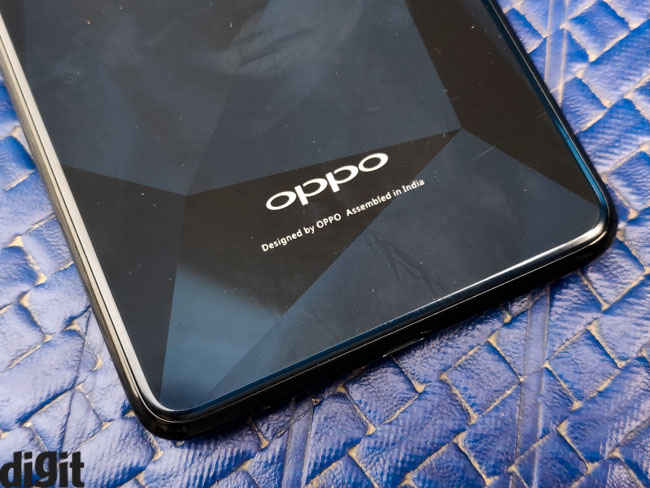
The front is all screen. There are no capacitive navigation button on the front. Even the fingerprint sensor is missing. The Realme 1 relies only on facial recognition for authentication. It’s a brave move by a brand that’s taking its first plunge in a highly competitive market, and other than just being perceived as future forward, it’s actually detrimental to the experience. The user loses out on the reliability of the fingerprint when authenticating purchases. The face unlock is quick, but isn’t reliable enough to keep user’s data secure. You can use facial authentication to access the private space (where you can store apps and data securely), and private apps (that are password-locked). In a practical scenario, the phone was unlocked by a colleague by simply pointing it at my face from a distance.
Apart from the diamond-black finish, it’s a pretty straightforward phone. It rocks the in-vogue univisium form factor and is just 7.8mm thick. There’s an ugly bulge along the edge of the phone that messes with the grip. The screen takes up most of the real-estate up front. The screen-to-body ratio is around 84 percent, which Realme managed to do by fitting the usual 6-inch display in a smaller 6.14-inch frame. The phone is offered in two more colours — Red and silver, but that will be available later in June.
Display
The Realme 1 sports a standard-issue 6-inch Full HD+ display of 18:9 aspect ratio. The panel is just about average with decent colour reproduction. The colour tones are slightly on the cooler side and brightness isn’t high enough to be visible properly when outdoors. In fact, there’s some colour loss at peak brightness and texts appear faded under direct sunlight. The panel quiet reflective too. You get the usual blue-light filters and options to tweak the colour temperature.
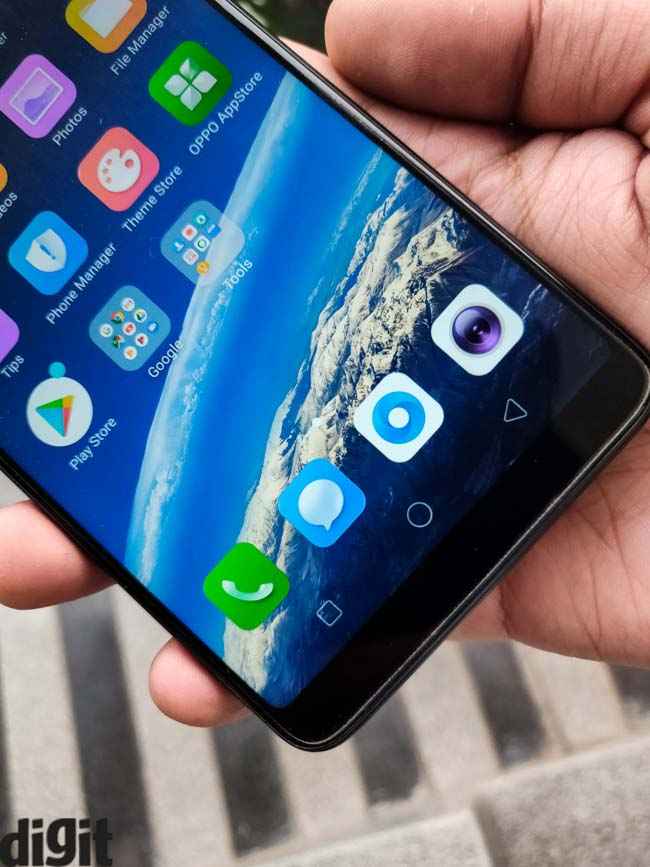
The good part about the panel is that it takes up most of the real estate up front with minimal bezels on the top and the bottom. The sides are also quite thin, which gives off an immersive feel to the content.
Performance and UI
The Realme 1 wants to be the phone of choice for mid-range buyers. The undercutting price point is one instance where it shows. But more than that, it’s the brand’s attempt to beat the best in its maiden attempt that brings out the competitive attitude of the company.
The Realme 1 is powered by the MediaTek Helio P60 SoC which is MediaTek’s most advanced chipset. It comes with an AI chip inside that can compute machine learning tasks on the device itself. It is what powers the facial recognition and the battery efficiency, apart from other things. It’s an octa-core chipset built on a 12nm FinFET process with four Cortex A53 and four Cortex A73 cores, all clocked at 2GHz frequency. On paper it’s faster than its Qualcomm counterpart, as the benchmark results from AnTuTu 7.0 and Geekbench will state. However, when I monitored how the chipset was being used, I observed some anomaly. It seemed for both the benchmark tests, which is comprised of multiple small tasks that stress the CPU to measure performance, the chipset was running at a constant 2.0GHz, irrespective whether the load on the CPU was minimal or at its peak. It could either be an anomaly with the unit I received or Realme is gaming a popular benchmark tests. In a more real world scenario, when the performance was measured while playing the new PubG Mobile game, the CPU speed matched the load put on it. The AnTuTu score for the Realme 1 was 138260 against the Redmi Note 5 Pro’s 112652. The Geekbench Single Core and Multi Core scores are also higher at 1490 and 5682 respectively. But in both cases, the CPU was artificially plonked up to eke out a better score.
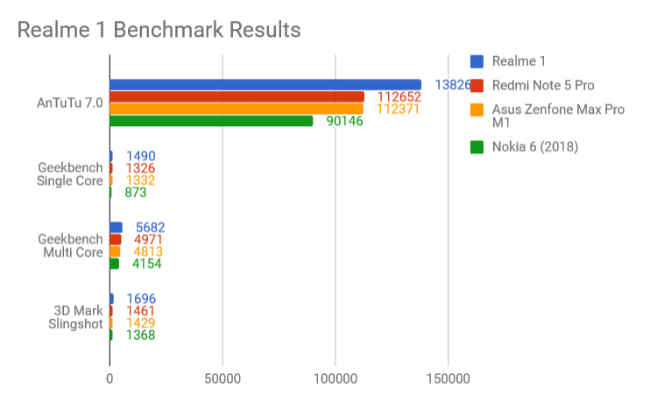
We performed a similar analysis on the Redmi Note 5 Pro which proved to be more consistent in responding to CPU load both during synthetic benchmark tests and real world scenarios. The Realme 1’s anomaly seems a little too deliberative. Nevertheless, there’s 6GB RAM and 128GB storage on the unit we re. It leaves enough resources free despite a heavy user interface. It also support dual VoLTE which is useful in the Indian context.
The Realme 1 relies on Oppo’s Colour OS. It’s definitely functional like all Android-layered user interfaces these days, but I wouldn’t call it particularly appealing. It lacks the attention to detail that MIUI is known or the simplicity of stock Android. Instead, the UI seems cluttered with disproportional icons and overall looks quite cartoonish. It does come with a game mode, a private space and the usual bells and whistles of Android Oreo, but that doesn’t take away the fact how uninviting the UI looks for a nitpicking user.
Camera
The fate of smartphones these days is decided by how good the camera is. The Realme 1, in that section, is quite underwhelming in comparison to the competition. It has a single 13-megapixel sensor at the back while on the front is an 8-megapixel shooter. The focus, unsurprisingly, is on selfies and portrait shots. The phone relies on Oppo’s AI algorithms to fine-tune the photos which the company claims works by analysing 296 recognition points to understand the skin tone, age, gender, etc. Based on that analysis, the phone applies one of 8 million ‘beauty solutions’ to the image.
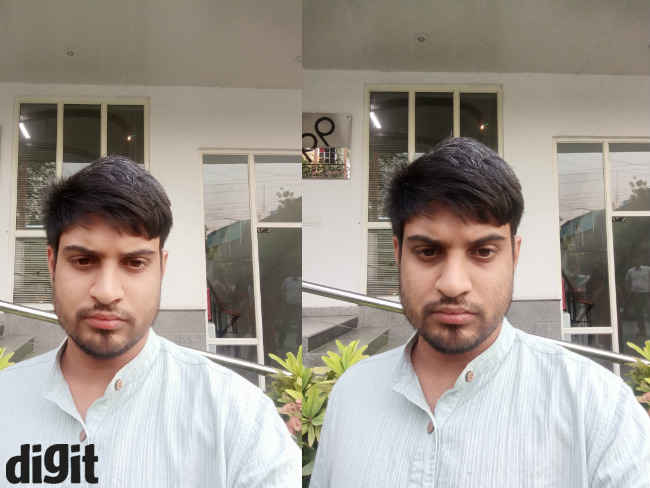
The end result is simply a photo with extreme layers of softening, so much so, that all spots and blemishes are hidden. It was a tad difficult for me to accept the effects, but I suppose there’s a demand for them in a country where fairness creams are one of the highest selling products. If beautification is what you’re seeking from a smartphone camera, the Realme 1 will be a pure delight. But if you’re a little more serious about taking good photos, the phone might leave you hanging.
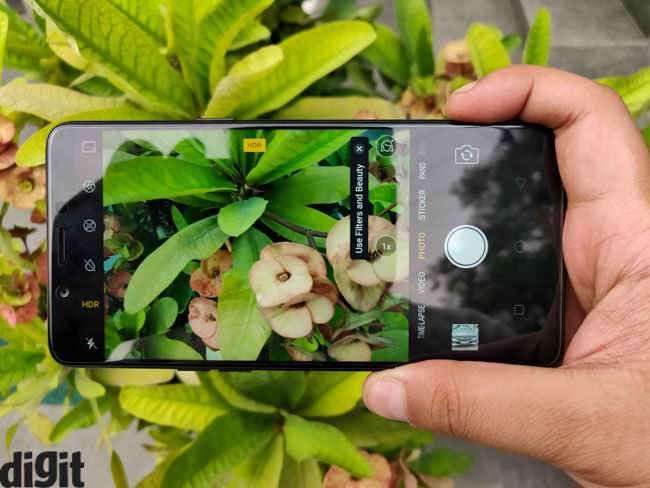
In daylight, the photos have ample highlight clipping. There’s practically no detail in the bright sky in the photo below. Furthermore, the camera tends to saturate the colours more than they are in reality. It also lacks the desired dynamic range.
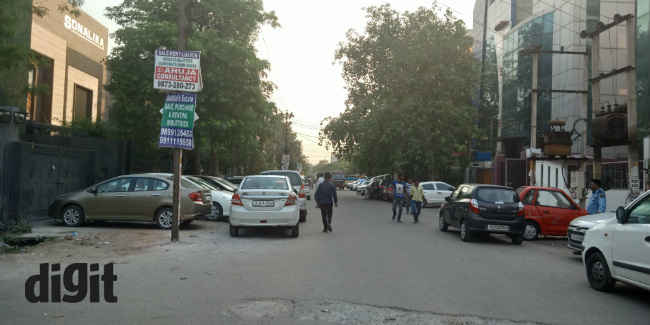
Indoor shots are a little more polished. The controlled light brings out the good side of the camera. There’s more controlled AI enhancement and the little that it does, it makes objects look much better than they are in real. You get good sharp images with a slightly warmer white balance. There’s some glare off the source of light though, which might be a lens issue.
Under low light, the camera fails to show much promise. Grains show up if you try to dial the exposure higher to take an image under poor lighting, with little to no detail. The shutter speed is actually dialled up when there’s less light which demands a steady hand and if the object is moving, you get a blurred photo.
The portrait mode is present both on the front and the back camera. The Realme 1 relies on software to simulate the depth-of-field effect. It’s nowhere as consistent as the Redmi Note 5 Pro, but it does the job as far as blurring the background is concerned.
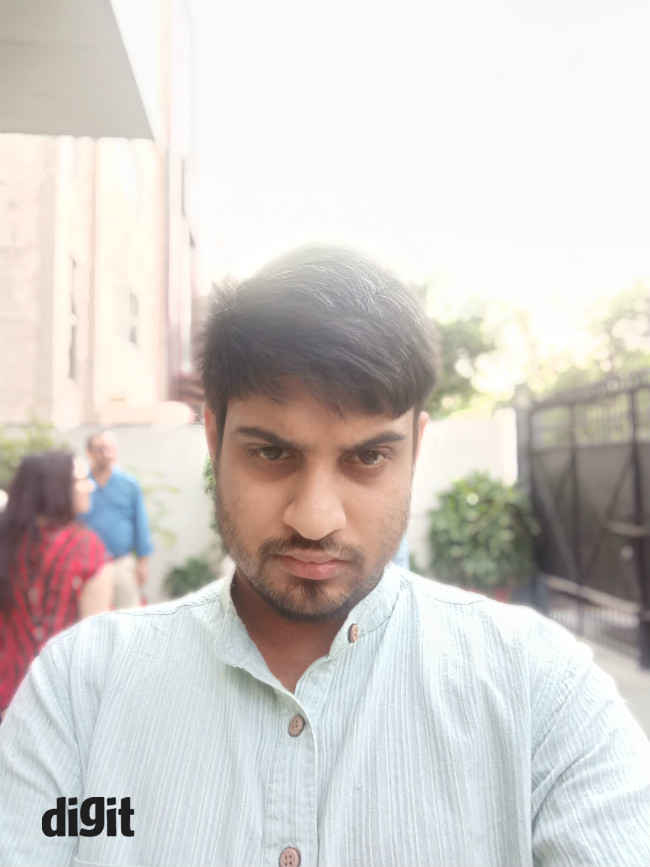
Battery
The Realme 1 is powered by a 3410mAh battery. For those comparing, that’s a hairline more than what Xiaomi’s best mid-range phone offers, and the battery life of the phone is more or less at par. The phone managed to run for 6 hours on the PCMark Battery 2.0 Test which should easily convert to over a day’s usage for an average user. For the review, I used the phone to browse the internet, play games, take photos and use social media. It did last me for a typical work day and then some more. The Helio P60 chipset seems to be quite energy-efficient and based on the battery life, Realme seems to be delivering on its promise of using machine learning to manage resources. The battery section in the Settings app gives some insight in how much juice each app takes and apart from the resource-intensive game I was playing, the UI sucked up most of the battery. When you are running out of power on this phone, you know what to blame.
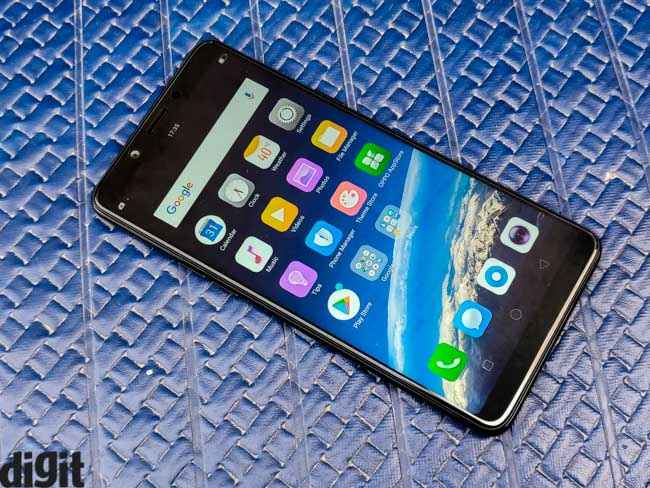
Bottomline
The debutante Realme 1’s ambition to compete with the likes of Xiaomi Redmi Note 5 Pro is quite apparent. It looks boldly different from the rest, but a good design will only take it so far. The performance is nowhere near the best in the market, despite the benchmark results telling you so. The camera which is propped up by on-device machine learning ends up delivering unnaturally softened photos while the UI comes off quite amateurish. The battery life is the only saving grace, but overall this phone isn’t what it advertises to be. Oppo’s decision to come out with a new sub-brand to cater to the highly competitive mid-range market may be driven by consumer demand, but there’s little in the phone to entice buyers, apart from a good looking device.
| Price: |
 Rs. 10999
Rs. 10999
|
| Release Date: | 25 May 2018 |
| Variant: | 32GB , 64GB , 128GB |
| Market Status: | Launched |
 Screen Size
Screen Size
 Camera
Camera
 Memory
Memory
 Battery
Battery

Digit caters to the largest community of tech buyers, users and enthusiasts in India. The all new Digit in continues the legacy of Thinkdigit.com as one of the largest portals in India committed to technology users and buyers. Digit is also one of the most trusted names when it comes to technology reviews and buying advice and is home to the Digit Test Lab, India's most proficient center for testing and reviewing technology products.

We are about leadership-the 9.9 kind! Building a leading media company out of India.And,grooming new leaders for this promising industry.


Digit caters to the largest community of tech buyers, users and enthusiasts in India. The all new Digit in continues the legacy of Thinkdigit.com as one of the largest portals in India committed to technology users and buyers. Digit is also one of the most trusted names when it comes to technology reviews and buying advice and is home to the Digit Test Lab, India's most proficient center for testing and reviewing technology products.

We are about leadership-the 9.9 kind! Building a leading media company out of India.And,grooming new leaders for this promising industry.


Shruti Modi reached Narcotics Control Bureau's office in south Mumbai today for questioning
A member of the Narcotics Control Bureau (NCB) team probing drugs angle in actor Sushant Singh Rajput's death case has tested positive for coronavirus on Wednesday following which questioning of the actor's former manager Shruti Modi has been postponed, an official said.
Shruti Modi reached the NCB office in south Mumbai around 10 am for questioning by the Special Investigation Team (SIT).
But, before the probe team could start recording her statement, the NCB received report of one of its SIT members testing positive for coronavirus, the official said.
The SIT member's antigen test came out positive, he said, adding that other members of the probe team will also be tested and all protocols will be followed.
"Accordingly, we sent back Shruti Modi who had joined the investigation in the morning," he said.
The NCB on Tuesday asked Shruti Modi and Sushant Singh Rajput's talent manager Jaya Saha to join its investigation to get a better picture on some aspects of the case. Jaya Saha will now be called later, the official said.
So far, the top drug law enforcement agency has arrested 18 people, including Sushant Rajput's friend and actress Rhea Chakraborty and her brother Showik Chakraborty.
Earlier, statements of Shruti Modi and Jaya Saha were recorded by the Central Bureau of Investigation (CBI), which is separately probing the Sushant death case.
They were also questioned by the Enforcement Directorate (ED) and the Mumbai Police in connection with cases linked to the actor's death probe.
Chats of Jaya Saha with Rhea Chakraborty had come to light during the ED's questioning, the official added.
Sushant Singh Rajput (34) was found hanging in his flat in Mumbai's suburban Bandra on June 14.

Chicago Cubs' Javier Baez (9) hits a home run against the Cleveland Indians during the second inning of a baseball game, Tuesday, Sept.15, 2020, in Chicago. (AP Photo/David Banks)
CHICAGO: Willson Contreras and Cameron Maybin were plunked by consecutive pitches from Cleveland reliever Nick Wittgren in the ninth inning, forcing home the winning run as the Chicago Cubs beat the Indians 6-5 Tuesday night.
After Cleveland tied the game at 5 with two runs in the top of the ninth, left-hander Oliver Prez (1-1) allowed a one-out walk to Kris Bryant in the bottom of the inning. Anthony Rizzo followed with a single that advanced Bryant to third. Wittgren drilled Contreras with a 1-1 fastball, then hit Maybin with a bases-loaded changeup.
Trailing 5-3 in the ninth, Josh Naylor drew a leadoff walk from Cubs closer Jeremy Jeffress. One out later, Francisco Lindor hit a two-run shot to left to tie the game. It was his eighth of the season and the second blown save for Jeffress (4-1).
Javier Bez also homered for the Cubs, who increased their lead to five games in the NL Central.
Lindor’s home run took away a victory for Cubs starter Yu Darvish. The NL Cy Young Award candidate allowed three runs and nine hits over seven innings. He struck out seven and walked one as he bounced back from a loss to the Reds in his last outing.
Rookie Tyler Naquin was 4 for 4 for the Indians, who lost their season-high seventh straight game.
With the score tied at three in the seventh, Indians reliever James Karinchak walked Bryant with one out. Bryant advanced to third on Rizzo’s single, and Contreras followed with a sacrifice fly to right to score the go-ahead run.
Bez manufactured an insurance run in the eighth. He walked, stole second and came around to score after catcher Sandy Len’s throw went into center. Baez never hesitated, rounding third and beating Cleveland’s relay.
Happ doubled to center for the Cubs in the fifth and scored on Bryants single. Rizzo followed with an RBI double to tie the game at 3.
Lindor had three hits and four RBIs, including a run-scoring double during a two-run third. He was later thrown out at home by right fielder Jason Heyward on Jos Ramrezs flyout.
DeShields doubled with one out in the fifth and scored on Lindor’s single to give the Indians a 3-1 lead.
With one out in the second inning, Bez hit a towering home run to straightaway center field to put the Cubs up 1-0. It was Baezs seventh of the season.
Indians starter Carlos Carrasco pitched six innings and allowed three runs and eight hits with five strikeouts and one walk in the no-decision.
TRAINER’S ROOM
Cubs: RHP Tyler Chatwood suffered a setback in his hopes of returning from a forearm strain . I don’t want to make a statement that his season is over, but I would say there is definitely a lot of caution, said Cubs manager David Ross.
UP NEXT
Indians: RHP Aaron Civale (3-5) is scheduled to start Wednesday against the Cubs. He has gone at least six innings in all nine of his starts this season, despite losing three of his last four starts.
Cubs: LHP Jon Lester (2-2), who is coming off one of his best starts of the season, is Chicago’s scheduled starter. He struck out a season-high eight batters in six scoreless innings against the Brewers on Friday.
___
More AP MLB: https://apnews.com/MLB and https://twitter.com/AP_Sports
Little by little, medical researchers are beginning to uncover more about the 2019 novel coronavirus. Until the vaccine or an effective drug becomes available, prevention remains the best way to control the spread of this highly contagious pathogen. Meanwhile, there are those who were hospitalised due to mild or severe symptoms and eventually discharged after tests confirm they were negative. However, scientists are still baffled by the long-term effects that continue to incapacitate people even after they have fully recovered.
Therefore, leading experts have been called in to find out what is causing these cycles of illnesses. The main complaints from patients include brain fog, chronic fatigue, and difficulty in breathing. "At the moment it is just so unknown. We're still very much at the point where we're learning what the after-effects are," explained co-investigator Dr. Rachael Evans. "It has become very apparent that the long-term effects can happen to people that were young and fit before and perhaps had a fairly mild acute illness... enough to bring them to hospital but maybe only a day or two."
One of the cases that were highlighted involved a 22-year-old patient who was considered physically fit prior to her being diagnosed with COVID-19. It has been six months since her recovery, but she still suffers from irregular heart rate, fever, nausea, and chronic fatigue. Upon checking her medical history, there were reportedly no pre-existing conditions.
The respiratory consultant pointed out that most pneumonia cases can take up to three months to make a full recovery. On the other hand, patients who tested positive for SARS-CoV-2 continue to experience various symptoms for much longer. In her 23 years with the National Health Service (NHS) there has been no recorded precedent in respiratory medicine, reports the Evening Standard.
As such, the post-hospitalisation COVID-19 study (PHOSP-COVID) is a UK-wide collaboration between leading researchers. It is an effort to better understand and provide care for people with long-term effects of the disease.
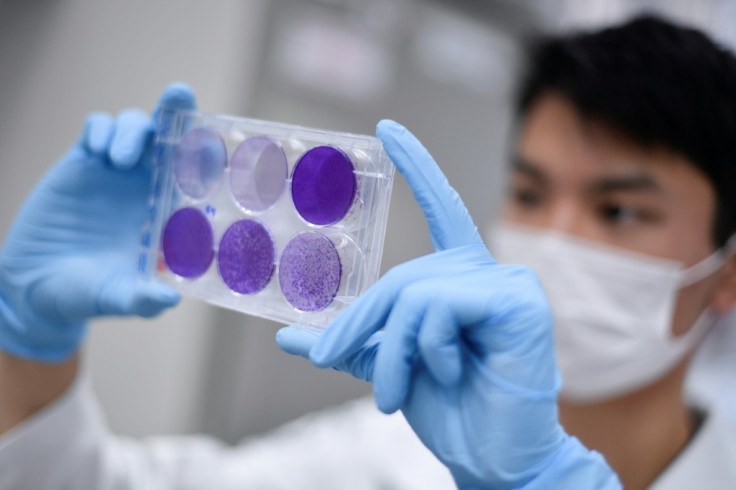
The study hopes to recruit 10,000 COVID-19 patients who have recovered and monitor them for a year or longer. Funding will be provided by the UK Research and Innovation group along with the National Institute for Health Research. The ultimate goal is to discover treatments and learn how to prevent various long-term effects.
All Comments ()+^ Back to Top